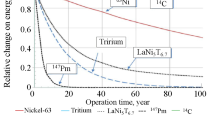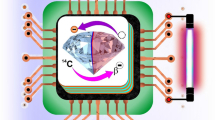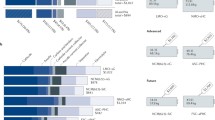Abstract
Nuclear batteries are devices that provide electrical power by converting the energy of radioactive decays. Their full operational potential depends on the actual limits set by the specific power (W/g) released by a radioisotope. This paper analyzes the main features of α-, β‒- or γ-emitting radioisotopes most qualified to run nuclear batteries, and provides updated values of specific power released by their decays as well as specific total energy (kWh/g) supplied over a given working period. When it is the case, the contribution coming from the daughter radionuclide is also taken into account.

Similar content being viewed by others
References
Moseley HGW, Harling J (1913) The attainment of high potentials by the use of radium. Proc Royal Soc 8(605):471–476
Barham OM (2021) Comparing nuclear and chemical power sources for MEMS/NEMS applications. Proceedings of the ASME 2021 International Design Engineering Technical Conferences and Computers and Information in Engineering Conference. Volume 11: 15th International Conference on Micro- and Nanosystems (MNS). Virtual, Online. August 17–19, 2021. V011T11A018. ASME Proc ASME
Spencer MG, Alam T (2019) High power direct energy conversion by nuclear batteries. Appl Phys Rev 6:031305
Lioliou G, Barnett AM (2022) Electron-hole pair creation and conversion efficiency in radioisotope microbatteries. Appl Radiat Isot 180:110042
Iwan A, Pellowski W, Bogdanowicz KA (2021) Conversion of Radiophotoluminescence Irradiation into Electricity in Photovoltaic cells. A review of theoretical considerations and practical solutions. Energies 14(19):6186
Litz M (2014) Isotope Beta-battery approaches for long-lived sensors: Technology Review. Army Research Laboratory-ARL-TR-7048
Yisong L, Yang Y, Li G, Liu Y, Xu J, Xiong X, Luo S, Peng T (2020) Demonstration and aging test of a radiation resistant strontium-90 betavoltaic mechanism. Appl Phys Lett 116:153901
Zamoryanskaya MV, Dementeva EV, Orekhova KN, Kravets VA, Trofimov AN, Gusev GA, Ipatova I, Burakov BE (2021) Self-glowing crystals-radioactive decay energy converters into optical emission. Mater Res Bull 142:111431
Terranova ML (2022) Nuclear batteries: current context and near-term expectations. Int J Energy Res 46(14):19368–19393
Ziegler JF, Ziegler MD, Biersack JP (2010) SRIM–The stopping and range of ions in matter. Nucl Instrum Meth Phys Res B 268(11,12):1818–1823
Wang X, Han Y, Zhang J, Li Z, Li T, Zhao X, Wu Y (2019) The design of a direct charge nuclear battery with high energy conversion efficiency. Appl Radiat Isot 148:147–151
Raffaelle RP (2021) Nanotechnology for Space Power Devices, in “Nanotechnology in Space” Terranova ML, Tamburri E Eds., J Stanford Publishing Ltd 2022, Chap. 1:1–21
Jiang T, Xu Z, Meng C, Liu Y, Tang X (2020) In-Depth analysis of the Internal Energy Conversion of Nuclear Batteries and Radiation Degradation of Key materials. Energy Technol 8(12):2020667
Schmidt GR, Sutliff TJ, Dudzinski LA Radioisotope Power: A Key Technology for Deep Space Exploration. Radioisotopes–Applications in Physical Sciences., Singh N, Ed (2011) ISBN: 978-953-307-510-5, In Tech.2011
Woerner DF (2018) Plans and Concepts for a new generation of RTGs for Planetary Science Missions. Proceedings of the 69th International Astronautical Congress, Bremen, Germany, 1 – 5 October 2018, IAC-18, C4, 7-C3.5, 1, x41922
Dustin JS, Borrelli PA (2021) Assessment of alternative radionuclides for use in a radioisotope thermoelectric generator. Nucl Eng Des 385:111475
Watkinson EJ, Ambrosi RM, Williams HR, Sarsfield MJ, Stephenson K, Weston DP, Marsh N (2017) Cerium neodymium oxide solid solution synthesis as a potential analogue for substoichiometric AmO2 for radioisotope power systems. J Nucl Mat 486:308–322
Tinsley T, Sarsfield M, Stephenson K, Ambrosi R (2019) Progress and future roadmap on 241Am production for use in Radioisotope Power Systems. IEEE Aerospace Conference 2–9 March 2019:1–8
Flicker H, Loferski J, Scott-Monck J (1962) Radiation defect introduction rates in N-and P-Type Silicon in the vicinity of the Radiation damage threshold. Phys Rev 128(6):2557–2563
Ellis BL, Fritzsche H, Patel J, Lang J, Suppiah S (2017) Titanium Tritide Films as Betavoltaic Power sources. Fusion Sci Techn 71(4):660–665
Russo J, Litz M, Ray IIW, Rosen GM, Cho H, Yu J, Bigio DI, Thomas C, Alam TR (2019) Demonstration of a Tritiated Nitroxide Nuclear Battery. Appl Radiat Isot 144:93–103
Prelas MA, Tchouaso MT (2018) High Eefficiency Dual-Cycle Conversion System using Kr-85. Appl Radiat Isot 139:70–80
Wacharasindhu T, Kwon JW, Meier DE, Robertson JD (2009) Radioisotope Microbattery based on Liquid Semiconductor. Appl Phys Lett 95:014103
Prelas MA, Weaver CL, Watterman ML, Lukosi E, Schott R, Wisniewski D (2014) A review of nuclear batteries. Prog Nucl Energy 75:117–148
Walker P, Carroll JJ (2005) Ups and Downs of Nuclear Isomers. Phys Today 58:39–44
Hartouni EP (2009) An Assessment of Nuclear Isomers as an Energy Storage Medium. Space, Propulsion and Energy Sciences International Forum – SPESIF-2009, AIP conf Proc American Institute of Physics. Robertson GA Ed 1103:492–500
Tavares OAP, Medeiros EL, Terranova ML (2021) Partial alpha-decay half-life of 178Hfm2 isomer. Mod Phys Lett A 36(6):2150036
Bushnell DM, Moses RW, Choi SH (2021) Frontiers of Space Power and Energy. NASA/TM:0016143
Basu SK, Mccutchan EA (2020) Nuclear data sheets for A = 90. Nucl Data Sheets 165:1–329
Mikołajczak R, Bazaniak Z, Iller E (2005) Radioisotopes for medical and industrial use during the 50-year history of the Institute of Nuclear Research. Nukleonika 50(3):S83–S87
Motobayashi T (2014) World new facilities for radioactive isotope beams. Eur Phys J Web of Conferences 66:01013
Starovoitova VN, Grimm TL, Grimm K, Odeh FY, Peters WA, Afanasev A, Guardala N, Carroll J, Litz M, Adams T, Maximenko S (2018) Production of alpha and beta radioisotopes for nuclear batteries using a superconducting electron linac. ANS Trans 118(1):333–335
Latooffi NF, Alzubadi AA (2020) Investigation of the reaction cross-section for production the Radioactive Isotopes used in fabricating the Nuclear Batteries. IOP Conf Ser: Mater Sci Eng 757:012017
Alzubadi AA, Nassir SS (2021) Study of the Nuclear structure for some target nuclei used in the production of Beta-emitting Radioactive Isotopes for the fabrication of Nuclear Batteries. Iraqi J Sci 62(1):116–129
Lee H, Yim M-S (2016) Examination of spent fuel radiation energy conversion for electricity generation. Nucl Eng Des 300:384–392
Bé M-M, Chisté V, Dulien C, Mougeot X, Chechev V, Kuzmenko N, Kondev F, Luca A, Galan M, Nichols A, Arinc A, Pearce AC, Huang X, Wang B (2017) Table of Radionuclides (vol 6 A = 22 to 242). Bureau International des Poids et Mesures Edition, Laboratoire National Henry Becquerel, 13 978-92-822-2242-3. cea-02476385
Kondev FG, Wang M, Huang WJ, Naimi S, Audi G (2021) The NUBASE2020 evaluation of nuclear physics properties. Chin Phys C 45(3):030001
Doran HR, Cresswell AJ, Sanderson DCW, Falconi G (2022) Nuclear data evaluation of decay heat analysis of spent nuclear fuel over 1 – 100 kyear timescale. Eur Phys J Plus 137:665
Kaplan I (1962) Nuclear Physics, second ed. Addison-Wesley. Reading (Mass.) U.S.A. Chapter 10
Funding
This research did not receive any specific grants from funding agencies in the public, commercial or not-profit sectors.
Author information
Authors and Affiliations
Corresponding author
Ethics declarations
Conflict of interest
The author declares no conflict of interest.
Additional information
Publisher’s Note
Springer Nature remains neutral with regard to jurisdictional claims in published maps and institutional affiliations.
Rights and permissions
Springer Nature or its licensor (e.g. a society or other partner) holds exclusive rights to this article under a publishing agreement with the author(s) or other rightsholder(s); author self-archiving of the accepted manuscript version of this article is solely governed by the terms of such publishing agreement and applicable law.
About this article
Cite this article
Tavares, O.A.P., Terranova, M.L. Physical viability for nuclear batteries. J Radioanal Nucl Chem 332, 3933–3942 (2023). https://doi.org/10.1007/s10967-023-09034-9
Received:
Accepted:
Published:
Issue Date:
DOI: https://doi.org/10.1007/s10967-023-09034-9




